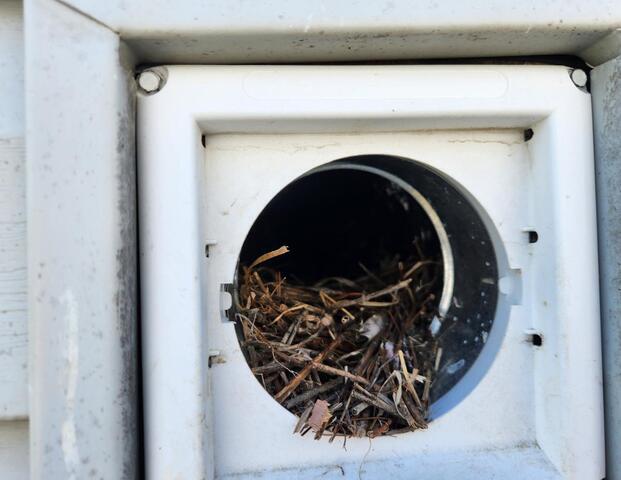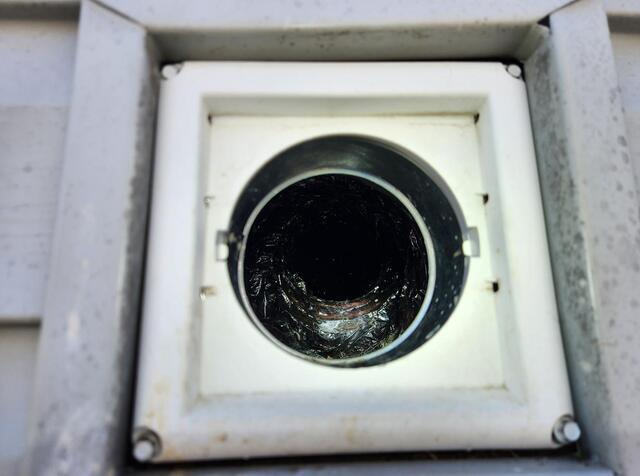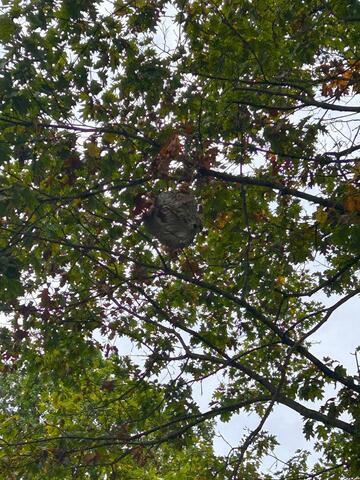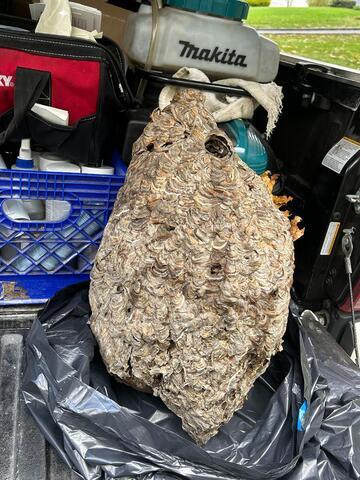Before & After Photos
Click on a photo to enlarge.
Behind the Wall is a Yellow Jackets Nest in Princeton, NJ
We were sent out on a service call for a new Home Protection Plan customer in Princeton, NJ who found an a yellow jackets nest in his bathroom! The owner was in the process of renovating the bathroom and when he removed a portion of the drywall close to the ceiling, he was attacked by several angry yellow jackets! The problem with yellow jackets nesting in the wall is that they think they are in the ground and will try to expand their nest by chewing through the infrastructure of the home!
For treatment, we injected a knockdown dusting application directly into the nest. This treatment exterminates the yellow jackets almost immediately. After several moments, we removed the nest, cleaned the area, and disposed of the nest. Now the owner can continue with his renovations without worrying about getting stung!
Starlings Clogged the Exhaust Vents in Princeton, NJ
After noticing a large amount of bird nesting debris in a couple of his exhaust vents as well as actually witnessing a number of starlings flying out of the areas, this customer in Princeton, NJ called Bird Solutions for help and we were sent out. Blocked airflow from nests can cause dryers to overheat and create fire hazards, while also potentially leading to moisture buildup, mold, and the spread of diseases like histoplasmosis from droppings.
The first thing we did was carefully remove all of the nesting debris out of each one of the exhaust vents. Afterward, we disinfected each of the exhaust vents with a solution that targets bird mites. Bird mites are parasites that feed on the blood of birds. When birds leave their nests, the mites are left behind without a suitable host for their next blood meal and make their way into a home.
Lastly, to prevent any future nuisance bird intrusions, we installed a Defender over each of the exhaust vents. The Defender is the perfect choice to help keep out nuisance birds. While allowing free-flowing air movement, its patented design effectively blocks intrusion by using a system of bars instead of a screen under the hood.
Keeping Birds Out of Hamilton Township, NJ Facility
Over the years Atlantic City Electric has been having issues with barn swallow flying in and nesting above the I- beams in the loading dock area. When asked by Cowleys pest control company for a solution, we immediately went out to the job site and installed Bird Slope on top of every I- beam. Bird Slope prevents birds from landing and nesting in those areas permanently.
Setting Up Our Devices for Rats in Bernardsville, NJ
A business owner was experiencing a rat issue around his property in Bernardsville, NJ, so he called Cowleys for help and we were sent out. After inspecting the entire property, we found a number of rat burrows in the back of the building near the stairs to the basement. Rats create burrows to travel from their nest to a food source and to escape predators. Rat burrows usually contain a main entrance and 1 or 2 exit holes away from the main entrance.
We installed a number Ready-to-Use rodent bait stations near each of the burrows. After that, we then installed several snap traps that are inside temper-proof, child resistant boxes near the burrows. We also filled in a few of the burrows that were no longer in use by the rats. Lastly, we scheduled several follow-up visits to monitor the rat infestation, apply any additional treatments, and replenish the bait stations as needed.
Bald-Faced Hornets Hover Above Homeowner in Bernardsville, NJ
As this customer in Bernardsville, NJ was mowing his lawn, he spotted a large hornet's nest in one of the trees in his front yard. He went inside his home and called Cowleys for help. Once we arrived, we equipped our protective bee suit and took a closer look at these stinging insects. When we did, we were able to identify them as bald-faced hornets. Bald-faced hornets are known to be extremely aggressive. They sense vibrations in the air and if anyone or anything comes remotely close to their nest, they will attack in full force!
Since the nest was about 10 feet up, we grabbed our extendable pole, attached a knockdown aerosol application to the pole, and began treated the nest with that product. After a few moments had passed, we then treated the nest with a knockdown liquid application. Both of these products will rapidly exterminate the bald-faced hornets. A short while after treating the nest, we removed it (and the branch it was attached it) and disposed of them properly.












